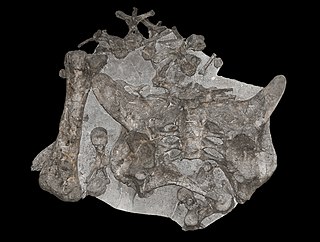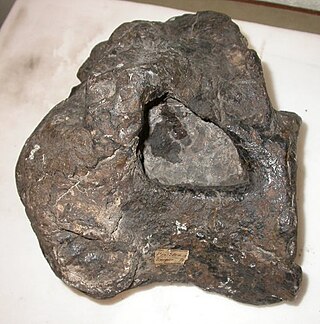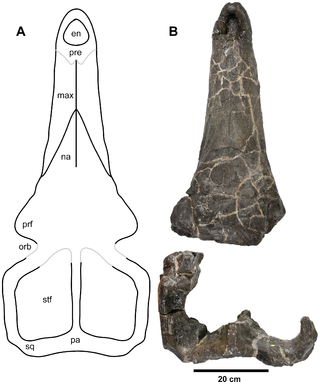
Plesiosaurus is a genus of extinct, large marine sauropterygian reptile that lived during the Early Jurassic. It is known by nearly complete skeletons from the Lias of England. It is distinguishable by its small head, long and slender neck, broad turtle-like body, a short tail, and two pairs of large, elongated paddles. It lends its name to the order Plesiosauria, of which it is an early, but fairly typical member. It contains only one species, the type, Plesiosaurus dolichodeirus. Other species once assigned to this genus, including P. brachypterygius, P. guilielmiimperatoris, and P. tournemirensis have been reassigned to new genera, such as Hydrorion, Seeleyosaurus and Occitanosaurus.

The Oxford Clay is a Jurassic marine sedimentary rock formation underlying much of southeast England, from as far west as Dorset and as far north as Yorkshire. The Oxford Clay Formation dates to the Jurassic, specifically, the Callovian and Oxfordian ages, and comprises two main facies. The lower facies comprises the Peterborough Member, a fossiliferous organic-rich mudstone. This facies and its rocks are commonly known as lower Oxford Clay. The upper facies comprises the middle Oxford Clay, the Stewartby Member, and the upper Oxford Clay, the Weymouth Member. The upper facies is a fossil poor assemblage of calcareous mudstones.

Dacentrurus, originally known as Omosaurus, is a genus of stegosaurian dinosaur from the Late Jurassic and perhaps Early Cretaceous of Europe.

Cetiosauriscus is a genus of sauropod dinosaur that lived between 166 and 164 million years ago during the Callovian in what is now England. A herbivore, Cetiosauriscus had – by sauropod standards – a moderately long tail, and longer forelimbs, making them as long as its hindlimbs. It has been estimated as about 15 m (49 ft) long and between 4 and 10 t in weight.

Cumnoria is a genus of herbivorous iguanodontian dinosaur. It was a basal iguanodontian that lived during the Late Jurassic period in what is now Oxfordshire, United Kingdom.

Ornithopsis is a genus of sauropod dinosaur, from the Early Cretaceous of England and possibly Germany. The type species, which is the only species seen as valid today, is O. hulkei, which is only known from fragmentary remains.

The Kimmeridge Clay is a sedimentary deposit of fossiliferous marine clay which is of Late Jurassic to lowermost Cretaceous age and occurs in southern and eastern England and in the North Sea. This rock formation is the major source rock for North Sea oil. The fossil fauna of the Kimmeridge Clay includes turtles, crocodiles, sauropods, plesiosaurs, pliosaurs and ichthyosaurs, as well as a number of invertebrate species.

Pliosaurus is an extinct genus of thalassophonean pliosaurid known from the Late Jurassic of Europe and South America. Most European species of Pliosaurus measured around 8 metres (26 ft) long and weighed about 5 metric tons, but P. rossicus and P. funkei would have been one of the largest plesiosaurs of all time, exceeding 10 metres (33 ft) in length. This genus has contained many species in the past but recent reviews found only six to be valid, while the validity of two additional species awaits a petition to the International Code of Zoological Nomenclature. Currently, P. brachyspondylus and P. macromerus are considered dubious, while P. portentificus is considered undiagnostic. Species of this genus are differentiated from other pliosaurids based on seven autapomorphies, including teeth that are triangular in cross section. Their diet would have included fish, cephalopods, and marine reptiles.

Plesiosuchus is an extinct genus of geosaurine metriorhynchid crocodyliform known from the Late Jurassic of Dorset, England and possibly also Spain. It contains a single species, Plesiosuchus manselii.

Leptocleidus is an extinct genus of plesiosaur, belonging to the family Leptocleididae. It was a small plesiosaur, measuring only up to 3 m (9.8 ft).

Kimmerosaurus is an extinct genus of plesiosaur from the family Cryptoclididae. Kimmerosaurus is most closely related to Tatenectes.

Colymbosaurus is a genus of cryptoclidid plesiosaur from the Late Jurassic (Callovian-Tithonian) of the UK and Svalbard, Norway. There are two currently recognized species, C. megadeirus and C. svalbardensis.

Brachypterygius is an extinct genus of platypterygiine ophthalmosaurid ichthyosaur known from the Late Jurassic of England. The type species was originally described and named as Ichthyosaurus extremus by Boulenger in 1904. Brachypterygius was named by Huene in 1922 for the width and shortness of the forepaddle, and the type species is therefore Brachypterygius extremus. The holotype of B. extremus was originally thought to be from the Lias Group of Bath, United Kingdom, but other specimens suggest it more likely came from the Kimmeridgian Kimmeridge Clay of Kimmeridge Bay, Dorset, UK.

Nannopterygius is an extinct genus of ophthalmosaurid ichthyosaur that lived during the Middle Jurassic to the Early Cretaceous. Fossils are known from England, Kazakhstan, Russia, and Norway and six species are currently assigned to the genus.

Pachycostasaurus is an extinct Pliosauroid from the Oxford Clay formation of Peterborough, England.

Torvoneustes is an extinct genus of metriorhynchid thalattosuchian. It is known from skull and postcranial remains found in the Kimmeridge Clay Formation of Dorset and Wiltshire, England, the Virgula Marls of Switzerland and also from Oaxaca, Mexico . The holotype skull of the type species was initially assigned to the species Metriorhynchus superciliosus. Postcranial remains were later discovered from the same quarry as the skull, and then these specimens were recognised as belonging to a new species of Dakosaurus, as D. carpenteri. The species was named to honour Simon Carpenter, an amateur geologist from Frome in Somerset, who discovered the fossils.

Juratyrant is a tyrannosauroid dinosaur genus from the late Jurassic period of England. The genus contains a single species, Juratyrant langhami, which was once classed as a species of Stokesosaurus.

Bathysuchus is an extinct genus of teleosaurid thalattosuchian from Late Jurassic (Kimmeridgian) deep water marine deposits in England and France. Bathysuchus displays features that suggest it was more pelagic than other teleosaurids, including smoother skull bones and reduced armour plating, similar to the fully marine metriorhynchids. This was possibly an adaptation to rising sea levels during the Kimmeridgian, as its earlier relatives such as Teleosaurus were suited for shallow coasts and lagoon environments.
Spitrasaurus is an extinct genus of cryptoclidid plesiosauroid plesiosaur known from the uppermost Jurassic of central Spitsbergen, Norway and likely also Kimmeridge, England. It is named after a syllabic abbreviation for Spitsbergen Travel.

Thalassodraco is an extinct genus of ophthalmosaurid ichthyosaur from the Late Jurassic (Tithonian) Kimmeridge Clay Formation of England. The type species, T. etchesi, was named in 2020, with the epithet in honour of the discoverer of the holotype, Steve Etches.



























